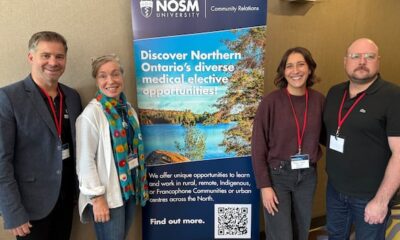Top Stories
Northern Communities Surge in Greenhouse Food Production

URGENT UPDATE: Northern communities are redefining food production with a surge in greenhouse initiatives, as seen in Salluit, Quebec, where the Amaat Society has successfully completed its first full harvest. The community produced over 115 kilograms of fresh fruits and vegetables this summer, an impressive feat for a region not typically associated with lush agriculture.
Located in Nunavik, Salluit’s greenhouse is the third of its kind in the region, following those in Kuujjuaq and Kangiqsualujjuaq. This innovative project aims to combat food insecurity and foster self-sufficiency among remote communities. President of the Amaat Society, Steven Grasser, reported overwhelming enthusiasm from locals: “When we give away produce on FM radio, we often have to turn people away due to high demand,” he stated.
Food security remains a critical issue in northern Canada, with nearly 60% of Quebec Inuit experiencing food insecurity, according to Statistics Canada. Grasser emphasized the importance of greenhouses, saying, “It’s about communities taking control of what they want to eat.” As rising costs of imported produce strain budgets, local greenhouses offer a sustainable solution.
Meanwhile, Andrew Spring, a Canada Research Chair at Wilfrid Laurier University, underscores the growing movement for greenhouses in Arctic communities. He believes these facilities are part of a broader strategy to enhance food sovereignty. Although greenhouses alone cannot solve food insecurity, they are vital for empowering communities to grow their own food.
The construction of Salluit’s greenhouse cost approximately $350,000, with annual operating expenses around $25,000. Despite the high costs, Grasser remains optimistic about the long-term benefits. He noted that the greenhouse fosters community spirit and encourages local residents to explore growing their own food.
In Nunavik, educational initiatives are also underway. Agronomist Sam Chauvette is actively involved in teaching local children about the biology of plants, turning their visits to the greenhouse into engaging learning experiences. “Kids react as if we were offering them candies, but they are crunching on fresh carrots and cucumbers,” he remarked.
The potential for greenhouses is further illustrated by projects like the Naurvik project in Gjoa Haven, Nunavut, which has successfully utilized retrofitted shipping containers to grow food year-round. With funding from regional and federal sources, these greenhouses are powered by renewable energy, demonstrating a commitment to sustainability.
While maintenance and operational challenges persist, community members express a strong desire for locally grown produce. Technician Betty Kogvik highlighted the appreciation for fresh food, stating, “The community looks forward to receiving locally-grown produce, especially when store-bought items often arrive rotten.”
Moving forward, experts like Spring and Chauvette call for enhanced training and resources to empower locals in agricultural practices. “Communities are doing what they can, but more targeted support is needed to build agricultural capacity,” Spring asserted.
As these greenhouses continue to flourish, they represent not just a means of food production but a vital step toward self-sufficiency and community resilience in northern Canada. With the impact of climate change and rising food costs, the urgency for such initiatives has never been greater.
Stay tuned for more updates as northern communities embrace this green revolution.
-

 Politics1 week ago
Politics1 week agoSecwepemc First Nation Seeks Aboriginal Title Over Kamloops Area
-

 World4 months ago
World4 months agoScientists Unearth Ancient Antarctic Ice to Unlock Climate Secrets
-

 Entertainment4 months ago
Entertainment4 months agoTrump and McCormick to Announce $70 Billion Energy Investments
-

 Lifestyle4 months ago
Lifestyle4 months agoTransLink Launches Food Truck Program to Boost Revenue in Vancouver
-

 Science4 months ago
Science4 months agoFour Astronauts Return to Earth After International Space Station Mission
-

 Technology3 months ago
Technology3 months agoApple Notes Enhances Functionality with Markdown Support in macOS 26
-

 Top Stories1 month ago
Top Stories1 month agoUrgent Update: Fatal Crash on Highway 99 Claims Life of Pitt Meadows Man
-

 Sports4 months ago
Sports4 months agoSearch Underway for Missing Hunter Amid Hokkaido Bear Emergency
-

 Politics3 months ago
Politics3 months agoUkrainian Tennis Star Elina Svitolina Faces Death Threats Online
-

 Politics4 months ago
Politics4 months agoCarney Engages First Nations Leaders at Development Law Summit
-

 Technology4 months ago
Technology4 months agoFrosthaven Launches Early Access on July 31, 2025
-

 Top Stories3 weeks ago
Top Stories3 weeks agoFamily Remembers Beverley Rowbotham 25 Years After Murder





















